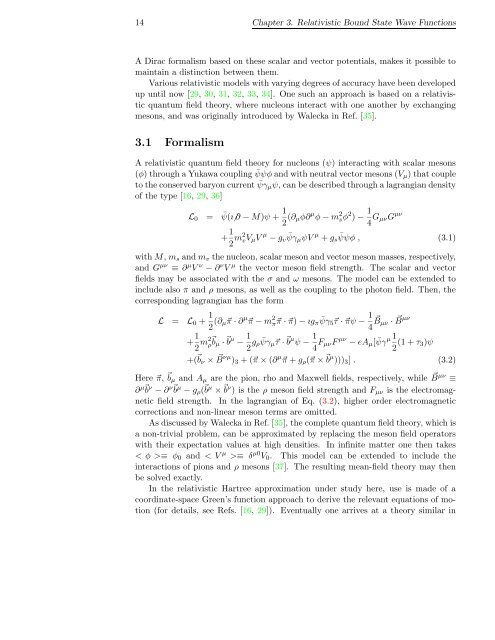Download Thesis in Pdf Format - Theoretical Nuclear Physics and ...
Download Thesis in Pdf Format - Theoretical Nuclear Physics and ...
Download Thesis in Pdf Format - Theoretical Nuclear Physics and ...
Create successful ePaper yourself
Turn your PDF publications into a flip-book with our unique Google optimized e-Paper software.
14 Chapter 3. Relativistic Bound State Wave Functions<br />
A Dirac formalism based on these scalar <strong>and</strong> vector potentials, makes it possible to<br />
ma<strong>in</strong>ta<strong>in</strong> a dist<strong>in</strong>ction between them.<br />
Various relativistic models with vary<strong>in</strong>g degrees of accuracy have been developed<br />
up until now [29, 30, 31, 32, 33, 34]. One such an approach is based on a relativistic<br />
quantum field theory, where nucleons <strong>in</strong>teract with one another by exchang<strong>in</strong>g<br />
mesons, <strong>and</strong> was orig<strong>in</strong>ally <strong>in</strong>troduced by Walecka <strong>in</strong> Ref. [35].<br />
3.1 Formalism<br />
A relativistic quantum field theory for nucleons (ψ) <strong>in</strong>teract<strong>in</strong>g with scalar mesons<br />
(φ) through a Yukawa coupl<strong>in</strong>g ¯ψψφ <strong>and</strong> with neutral vector mesons (V µ ) that couple<br />
to the conserved baryon current ¯ψγ µ ψ, can be described through a lagrangian density<br />
of the type [16, 29, 36]<br />
L 0 = ¯ψ(ı̸ ∂ − M)ψ + 1 2 (∂ µφ∂ µ φ − m 2 sφ 2 ) − 1 4 G µνG µν<br />
+ 1 2 m2 vV µ V µ − g v ¯ψγµ ψV µ + g s ¯ψψφ , (3.1)<br />
with M, m s <strong>and</strong> m v the nucleon, scalar meson <strong>and</strong> vector meson masses, respectively,<br />
<strong>and</strong> G µν ≡ ∂ µ V ν − ∂ ν V µ the vector meson field strength. The scalar <strong>and</strong> vector<br />
fields may be associated with the σ <strong>and</strong> ω mesons. The model can be extended to<br />
<strong>in</strong>clude also π <strong>and</strong> ρ mesons, as well as the coupl<strong>in</strong>g to the photon field. Then, the<br />
correspond<strong>in</strong>g lagrangian has the form<br />
L = L 0 + 1 2 (∂ µ⃗π · ∂ µ ⃗π − m 2 π⃗π · ⃗π) − ıg π ¯ψγ5 ⃗τ · ⃗πψ − 1 4 ⃗ B µν ·<br />
⃗B<br />
µν<br />
+ 1 2 m2 ρ ⃗ b µ ·⃗b µ − 1 2 g ρ ¯ψγ µ ⃗τ ·⃗b µ ψ − 1 4 F µνF µν − eA µ [ ¯ψγ µ 1 2 (1 + τ 3)ψ<br />
+( ⃗ b ν × ⃗ B νµ ) 3 + (⃗π × (∂ µ ⃗π + g ρ (⃗π × ⃗ b µ ))) 3 ] . (3.2)<br />
Here ⃗π, ⃗ b µ <strong>and</strong> A µ are the pion, rho <strong>and</strong> Maxwell fields, respectively, while B ⃗ µν ≡<br />
∂ µ ⃗ b ν − ∂ ν ⃗ b µ − g ρ ( ⃗ b µ × ⃗ b ν ) is the ρ meson field strength <strong>and</strong> F µν is the electromagnetic<br />
field strength. In the lagrangian of Eq. (3.2), higher order electromagnetic<br />
corrections <strong>and</strong> non-l<strong>in</strong>ear meson terms are omitted.<br />
As discussed by Walecka <strong>in</strong> Ref. [35], the complete quantum field theory, which is<br />
a non-trivial problem, can be approximated by replac<strong>in</strong>g the meson field operators<br />
with their expectation values at high densities. In <strong>in</strong>f<strong>in</strong>ite matter one then takes<br />
< φ >≡ φ 0 <strong>and</strong> < V µ >≡ δ µ0 V 0 . This model can be extended to <strong>in</strong>clude the<br />
<strong>in</strong>teractions of pions <strong>and</strong> ρ mesons [37]. The result<strong>in</strong>g mean-field theory may then<br />
be solved exactly.<br />
In the relativistic Hartree approximation under study here, use is made of a<br />
coord<strong>in</strong>ate-space Green’s function approach to derive the relevant equations of motion<br />
(for details, see Refs. [16, 29]). Eventually one arrives at a theory similar <strong>in</strong>















